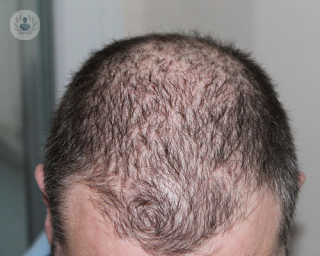Male pattern baldness
What is male pattern baldness?
Up to 95% of men can blame hair loss on male pattern baldness or androgenetic alopecia, which is a condition that causes men to lose their hair due to inherited genes from their parents. Men can lose their hair from as early as their teenage years.
Symptoms of male pattern baldness:
- A receding hairline
- Thinner strands around the crown of the head and the temples
- A horseshoe pattern of hair around the sides of the head, with a bald patch on the top

How is male pattern baldness diagnosed?
MPB is usually diagnosed by examining the pattern of hair loss, any family history of hair loss and the medical history of the patient. A dermatologist or hair surgeon can examine the scalp using a densitometer to look at the hair follicles and advise you on the best course of treatment. They may also use a hair loss chart called the Norwood Scale to compare the extent of the hair loss in order to measure the severity of the condition.
What causes male pattern baldness?
Male pattern baldness is caused by genes. There is a gene that makes hair follicles more sensitive to a hormone called DHT or dihydrotestosterone, which makes hair follicles shrink. As hair follicles shrink, they become shorter and thinner and eventually they become so small that no hair can grow in them. Hair stops growing and leads to male pattern baldness.
Can male pattern baldness be prevented?
As male pattern baldness is genetic, it can’t be prevented, but certain measures can be taken to delay the onset and to keep hair follicles as healthy as possible, such giving up smoking and following a healthy and balanced diet with more omega 3 and zinc.
How can male pattern baldness be treated?
There have been many recent developments to stop or slow down the progression of hair loss or to replace hair. Certain medications such as Minoxidil can slow down MPB, but once the medication is stopped, the hair will continue to fall out.
Finasteride, another form of medication has helped men to regrow new hair, but only for as long as the medication is used. Finasteride lowers DHT levels, the hormone that shrinks hair follicles and leads to baldness. Finasteride is more favourable and has proven more effective than Minoxidil as a treatment option.
Other treatments include low level laser therapy, which can slow down the progression of the hair loss.
A new treatment called Regenera uses cells from your scalp (by taking a couple of biopsies) which are then specially treated to release stem cells and growth factors, which are injected into balding areas to stimulate hair growth. This treatment is available in specialist centres.
Another option is a hair transplant, such as the FUE hair transplant technique, which takes hair from the sides and back of the head and transplants it to the top. This hair will shed after the transplant but within 6 months, it will grow back and start to look natural.
Other options include using a wig that matches your own hair colour and texture and using hair styling products that can add volume to the hair that you have.
If you are concerned about your hair loss and would like advise on how best to tackle it, find a specialist near you who can give you guidance and support.














